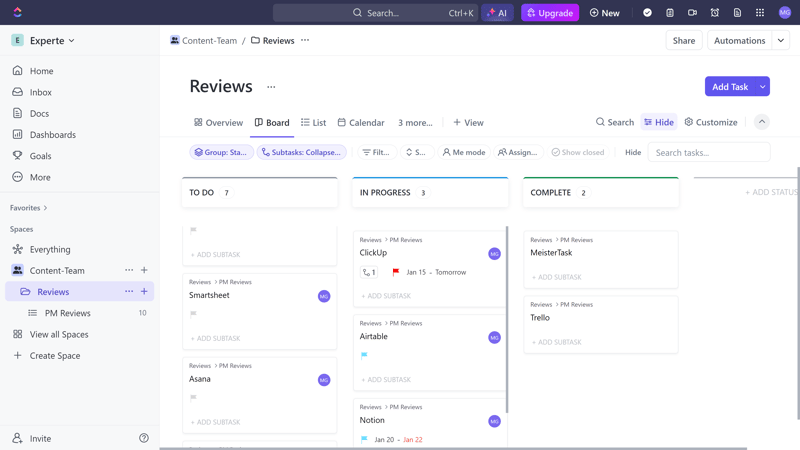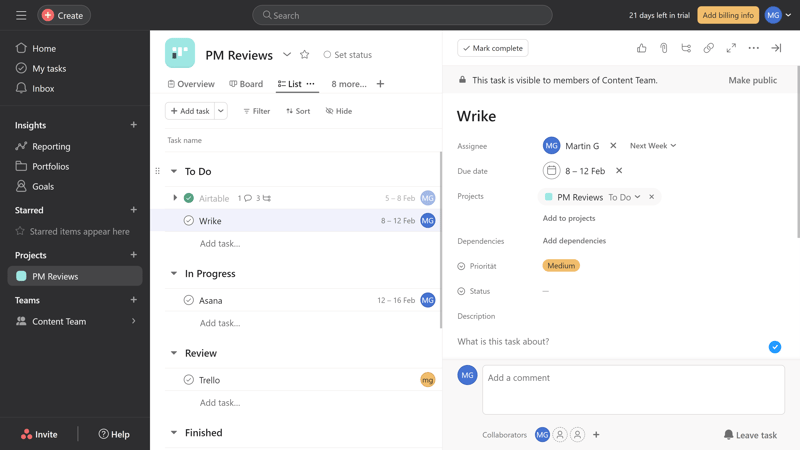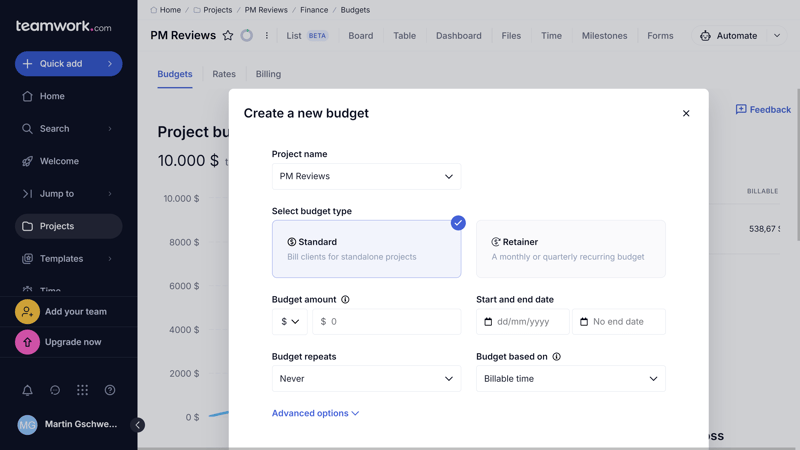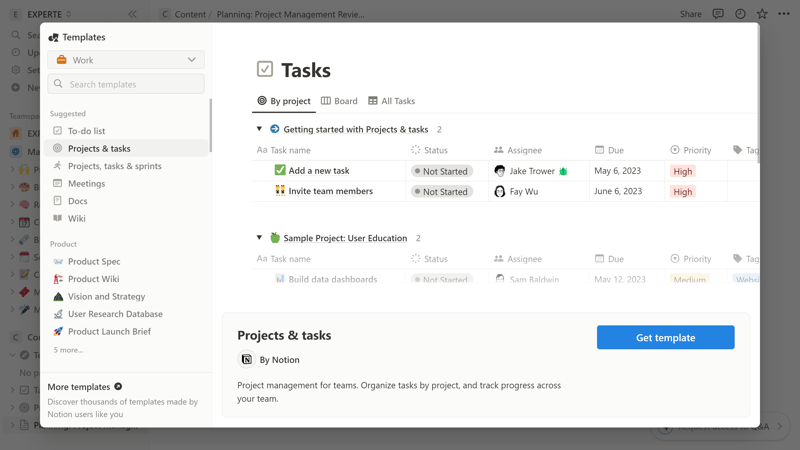Best Trello Alternative 2025: Our Top 5 Choices
For many, Trello serves as a gateway into the colorful world of project management software: Its agile task management in Kanban style is particularly easy to use. However, as teams' needs become more complex, they might outgrow Trello. When that happens, you'll need an alternative - but which one?
We'll show you some of the best Trello alternatives and explain what they do better (or worse) than the Kanban platform.
Potential Drawbacks of Trello
Why not Trello? You'll need to answer this question yourself - after all, you know your specific project needs and requirements best.
While Trello is a great platform, it's not the perfect solution for every team. Here are some of its main drawbacks:
Missing features
Trello limits its features to keep things simple. Unfortunately, this means it lacks some standard functions, like basic subtasks or dependencies - not to mention advanced features like reporting or time tracking.Limited customization
Trello isn't as flexible or customizable as other solutions. For example, your options for custom field types are limited.Project management only
Trello offers a user-friendly platform to track key project data and workflows - nothing more, nothing less. Other platforms are much more versatile and can work as a CRM or company wiki too.Few view options
Trello is an excellent Kanban tool, but it's not as strong beyond Kanban-based project organization. Other platforms offer many more views and ways to visualize projects.No real-time communication
Trello has few collaboration features. You can assign tasks and leave comments, but real-time teamwork isn't possible.Less suited for large and complex projects
Due to its limited features, especially at the task level, Trello isn't ideal for complex projects - like those with subtasks and task dependencies.Limited free plan
Trello has a solid free plan, but it's limited to ten boards total and the Kanban view. Other platforms can be more generous here.
Trello is a good choice for small and medium-sized teams who want to visualize their projects and progress in Kanban boards and can do without advanced features, visualizations, and customization options.
If Trello's limitations are keeping you from managing your projects and tasks well, you should look for an alternative.
Trello Alternatives: Our Top 5
We have thoroughly tested eleven of the most popular project management platforms. Trello ranked eighth with a "good" overall score – which means we liked some other tools a bit better. Here are our favorites:
monday.com: The Better All-Around Solution

monday.com* is a cloud-based project management platform that helps teams of all sizes and industries manage their projects and tasks. monday.com offers what we think is the best balance between ease of use and flexibility, which earned it the top spot in our ranking.
What Do We Like About monday.com?
monday.com includes almost all the features we expect from a modern project management hub, and they work great. The colorful interface is intuitive and easy to learn for beginners, the project hierarchy makes sense, and task management is flexible enough for most needs.
You can manage your projects and tasks using customizable boards, multiple views, custom field types, and advanced task management options – including subtasks and dependencies.

monday.com is more versatile than Trello.
What Makes monday.com Better Than Trello?
monday.com is more flexible and versatile than Trello. It can do everything Trello does, plus much more. Here are the advantages:
More Customizable
monday.com lets you store project information and other data in much more detail. You can customize your dashboard with different views, column variations, and integrations.More Views
Kanban boards are just one of many visualization options in monday.com. The platform offers eight different views – Trello only has five.More Custom Fields
The gap is even bigger with custom fields: monday.com supports 14 field types, while Trello only has five.More Task Features
With monday.com, you can easily break down tasks into subtasks, set up dependencies between them, and create milestones.Built-in Reporting
monday.com includes comprehensive reporting and analytics features that help you present project and other data in visually appealing ways.Better Support & Documentation
While monday.com is more complex than Trello, it also offers more extensive support resources.
Where Does monday.com Fall Short Compared to Trello?
While monday.com is user-friendly, it's a bit more complicated than Trello. For simple and smaller projects – especially those that mainly need Kanban-style visualization – Trello offers a much simpler home. Also, Trello is slightly cheaper than monday.com.
Other Drawbacks of monday.com
Even our top pick isn't perfect or suitable for all teams and project types. Here are the downsides:
Limited Communication Options
monday.com still needs to improve its collaboration tools. There are no direct messages or real-time communication channels.Price Barriers
Some important features and views are only available in higher-priced plans, which might rule out cheaper plans for many teams.Limited Free Version
monday.com's free plan could be better: It's limited to 200 items and only 2 team members.Not for Solo Users
Unfortunately, there are no individual licenses for premium plans. This means freelancers and solo users can only use the free version.
ClickUp: Much More Flexible Than Trello

ClickUp* is a productivity platform that you could call the anti-Trello. It follows a completely opposite approach: Instead of limiting its features, this self-proclaimed "One app to replace them all" aims to pack in so many features that you won't need any other software in this space.
What Do We Like About ClickUp?
ClickUp does a great job of organizing its many features and customization options in a user-friendly dashboard. "Customizable" is the key word here: ClickUp stands out not only for its huge range of features but also for letting you configure and personalize almost every button.
The platform stays easy to navigate thanks to its clear hierarchy and structure. You can split projects into different spaces and project folders, each with their own rules, members, and permissions. This gives you detailed project control at different levels.

ClickUp is one of the most versatile project management solutions available.
How Is ClickUp Better Than Trello?
ClickUp mainly does more than Trello – and most other platforms we reviewed. Here are ClickUp's advantages:
Many more features and flexibility
ClickUp offers much more variety and flexibility than Trello. You can store, organize, and display tasks and project data in different ways. You can customize almost every feature, setting, and view in detail.More views and field types
ClickUp also beats Trello with more views (10) and custom field types (12).Built-in real-time collaboration
ClickUp shines as a collaboration platform with real-time teamwork in documents, whiteboards, and group chats.Better free plan
ClickUp's free plan lets you create up to 100 lists (projects) with unlimited tasks and members.
Where Does Trello Beat ClickUp?
Compared to ClickUp, Trello is a lightweight tool, which has its benefits: Trello is more intuitive, quicker to set up, and more dynamic for simple projects. For basic projects, ClickUp might be too heavy and complex.
Other ClickUp Drawbacks
ClickUp's attempt to combine every possible productivity feature under one roof comes with some potential drawbacks:
Complex with a steep learning curve
ClickUp is more complex than other solutions, and its many options can overwhelm beginners. The screen is always quite busy, which might distract you from focusing on tasks.Slow and laggy
Unfortunately, ClickUp's interface isn't just complex - it sometimes stutters, which hurts the user experience and makes it less smooth to use.Not all features are polished
Not all of ClickUp's features are equally useful or can compete with dedicated apps. For example, collaborative document editing works much better with Google Docs and similar tools.
Asana: More Features, Just as User-Friendly

Want more features than Trello but still care about easy-to-use controls? Then check out Asana*. This project management platform, created by former Facebook employees, makes project management super user-friendly and, like Trello, stands out with its process-focused task views.
What We Like About Asana
Asana shines with its modern, snappy interface that makes project management dynamic and straightforward for everyone involved. It's almost fun to check off to-dos and tasks and break down complex processes with subtasks into their components.
Built into this excellent interface is a solid set of features that covers all important views and includes advanced task management and other features, including automations, reports, and forms.

Asana's interface is one of our absolute favorites.
What Makes Asana Better Than Trello?
Asana offers a better balance between features and ease of use. It shows that Trello wouldn't lose any of its user-friendliness by adding more views and features.
More flexible project management
Asana comes with a wider range of views, custom fields, and project management tools, making it more flexible than Trello overall.More task features
Asana supports subtasks, dependencies, and milestones. You can also set goals to work toward with your team.Better automation
While Trello has automation too, Asana makes it super easy to create automatic workflows and custom rules.Strong reporting features
Asana shines with excellent reporting tools that Trello doesn't have. You can see project data in real-time charts and combine them in dashboards.Better free plan
Asana's free option is one of the best out there: You get unlimited tasks and projects with no storage limits.
Where Does Trello Beat Asana?
Trello's premium plans cost about half as much as Asana's. Plus, you can use Trello Premium by yourself, while Asana's premium plans need at least two licenses.
Trello remains the top choice for teams who mainly use the Kanban method and don't need Asana's extra features.
More Drawbacks of Asana
Asana has some weak points too:
Less flexible than other platforms
Asana isn't as customizable as ClickUp and other tools. Its processes and buttons are more set in stone.Limited custom fields
Asana doesn't offer many ways to customize task properties. Your options for custom fields are limited.Basic collaboration features
While Asana lets you work together and send direct messages, it doesn't have quick chat or advanced collaboration tools.
Teamwork.com: Better for Agencies and Client Projects

Looking for a project management tool for client work? Teamwork.com* could be a great Trello alternative: The platform focuses on the needs of teams working on client projects – like agencies.
What Do We Like About Teamwork.com?
Teamwork.com offers a solid set of features that combines classic task and project management with advanced collaboration, budget, and resource management capabilities.
Teamwork.com excels at basic task management. You can view tasks in many different ways, create custom fields, and add subtasks and dependencies to provide more context.
It also includes strong collaboration features, like group chats, private messages, and real-time document editing, plus handy budget tracking, time tracking, and billing features.

Teamwork.com stands out from other platforms with its extensive budget features.
What Makes Teamwork.com Better Than Trello?
The pattern continues: Teamwork.com is much more versatile than Trello – and offers more features and options, especially for teams working closely with clients.
More Project Management Features
Teamwork.com offers more project management features than Trello right out of the box: It includes more views, more task-level options, and more custom fields.Built-in Resource Management
Teamwork provides resource management tools that help teams track workload and assign resources smartly.Budget and Billing
Teamwork.com helps teams manage their budgets: You can set a budget for each project and track hours precisely. You can even turn billable hours into invoices.Better Team Collaboration
Teamwork.com focuses more on teamwork and serves as a communication platform - with private messages, group chats, message boards, and wiki features.
Where Does Teamwork Fall Short Compared to Trello?
Trello is cheaper than Teamwork.com, with the starter plan costing about half as much. Trello is also quicker to set up, more focused with its Kanban approach, and better suited for simple projects. While Teamwork.com is designed exclusively for teams, Trello works well for individual users too.
Other Drawbacks of Teamwork
Teamwork.com shows some weaknesses, not just when compared to Trello. Here are the main drawbacks:
More Complex Than Other Tools
Teamwork.com is bulkier and more complex than other platforms, and it takes longer to set up.Strong Agency Focus
Teamwork.com isn't for everyone: The platform specifically targets agencies and organizations working on client projects - its features might not fit other teams as well.German Version Needs Work
Teamwork.com's interface is only partly translated into German, and some translations aren't great. The entire support section is only available in English.Limited Field Types
The choice of custom field types is limited, which restricts how much you can personalize tasks.
Notion: The Wiki Alternative to Trello

Notion* stands out from the others in this list: It's not just a project management tool, but a knowledge base where you can arrange, organize, and display data and information however you want.
You can manage projects and tasks with it, but that's just one of Notion's many features. The platform works equally well as a company wiki, CRM tool, or budget planning platform.
What Do We Like About Notion?
Notion combines notes, task management, databases, wikis, and project management in one fully customizable tool. This versatility makes it a Swiss Army knife for personal and team productivity.
You can customize almost every part of your Notion pages, from simple to-do lists to complex project management boards, allowing for extensive personalization. Despite its huge range of features, Notion stays user-friendly with a clean design that makes navigation and organization easy.

Notion offers templates for many purposes.
How Is Notion Better Than Trello?
Since these platforms are so different, it's hard to compare them directly. Of course, Notion has many features and benefits that Trello intentionally doesn't include:
Many more features
Notion offers a wide range of features that go way beyond project management. It combines notes, document creation, databases, project management, and wikis in one tool.More views and task options
While project management is just one of many features, Notion is still better equipped here. It supports more views, field types, and task management tools than Trello, including subtasks and dependencies.Unlimited customization
You can customize any page in Notion with many types of content, from simple text to tables and embedded videos. You can tailor workspaces, databases, and documents to fit your needs perfectly.Documentation and knowledge management
With Notion, you can create detailed documents, build knowledge bases, and organize different types of information - from meeting notes to technical guides - in one central, easy-to-access format.
Where Does Notion Fall Short Compared to Trello?
While Notion supports Kanban-style project organization, it's just one of countless features, and definitely not the main focus. If you're looking for a tool for simple project management or task tracking, Notion might be too complex and feature-rich.
Trello, on the other hand, was specifically designed for the Kanban system and gives users a fast, simple, and streamlined experience.
More Disadvantages of Notion
Of course, Notion also has some drawbacks compared to other project management platforms:
Not a dedicated project management platform
Notion isn't a dedicated project management tool - it's a knowledge base with project management features. While these features are well-designed and polished, they're not the main focus.Longer setup time
Due to its high flexibility, it can take longer to customize Notion to your organization's needs. The processes and interfaces are less structured compared to other tools.Limited real-time communication
Notion doesn't have chat or private messaging features. It's not meant to be a communication platform.Missing features
Some advanced project management features like time tracking and comprehensive reporting tools aren't included in Notion's basic toolkit.
More Trello Alternatives We Reviewed
There are many other project management tools that can work as Trello alternatives. Here are some options:

Meistertask* is probably the most direct Trello competitor, as this German platform also focuses on Kanban. However, Meistertask takes a much stricter approach to Kanban - it offers few other functions, views, or ways of working, making it less versatile than Trello.

Wrike* is a team project management tool that's most similar to monday.com and Asana. It's more versatile than Trello and offers more features and views, but isn't as customizable as ClickUp. Beyond the free plan, Wrike isn't suitable for individual users.

Airtable* combines database, spreadsheet, and project management tools into a versatile hybrid solution, often nicknamed "Excel on steroids." It's much more complex and less process-oriented than Trello, making it especially good for data-focused projects.

Smartsheet* has more in common with Airtable than with Trello or other tools in our comparison. This complex, spreadsheet-based platform works best for data-heavy projects, as it lets you handle more complex project plans and workflows than Trello.

Basecamp* goes against the trend of project management tools that try to give users maximum flexibility in setting up their projects and tasks.
It comes with fairly structured workflows and guidelines, which makes Basecamp as user-friendly as Trello. It also includes built-in collaboration tools. However, Basecamp isn't the best choice for larger and complex projects.
Overall Results
You can find the complete ranking of all eleven project management tools we reviewed, with links to our detailed reviews, here:
Conclusion
The best Trello alternative depends on what bothers you about Trello. Are you looking for more flexibility in managing your projects, like more view options? You have plenty of choices:
monday.com is a flexible all-rounder that's more versatile than Trello in every way and can handle complex projects and different work styles.
ClickUp stands out with almost unlimited customization and built-in collaboration tools, but it's not as simple as Trello.
Asana is as user-friendly as Trello but offers more views and task-level features.
Teamwork.com focuses on customer-facing teams and comes with built-in budget and resource management features.
Notion is in a different league as a wiki platform with project management features. It's more complex but has many more uses - including Trello-like project management with Kanban boards.
You can read detailed reviews of these and other providers in our comparison of the best project management tools.
Frequently Asked Questions
Trello is a user-friendly project management tool from Atlassian that specializes in task visualization through Kanban boards. Teams can use Trello to visualize their tasks and track project progress.
Trello works best for small and medium-sized teams who want to visualize and track their tasks and simple projects using Kanban boards.
Many project management tools are similar to Trello because most of them offer Kanban board visualization. MeisterTask is particularly similar as it also focuses on the Kanban method, though it offers fewer features overall.
Trello is less versatile than other project management platforms, especially beyond Kanban-style project views. It has limited views and task customization options, and lacks important features like subtasks and dependencies. This makes Trello less suitable for complex projects.
The best Trello alternative depends on your team's specific needs. For example, monday.com, ClickUp, and Asana offer many more features and customization options, but they're also a bit more complex to use.
























